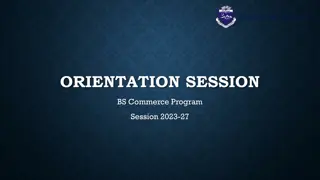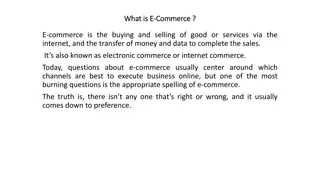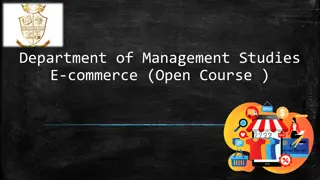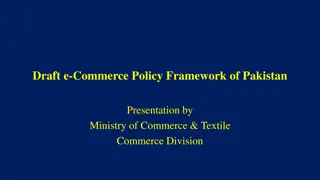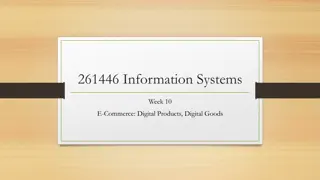Introduction to Business and Commerce: Scope, Significance, and Functions
This content covers the fundamentals of business and commerce, including the nature, scope, functions, and importance of business activities. It discusses business objectives, trends, globalization, and the significance of business in society. The scope of commerce, trade, and various business functions such as production, marketing, finance, and human resource management are also explored.
Download Presentation

Please find below an Image/Link to download the presentation.
The content on the website is provided AS IS for your information and personal use only. It may not be sold, licensed, or shared on other websites without obtaining consent from the author.If you encounter any issues during the download, it is possible that the publisher has removed the file from their server.
You are allowed to download the files provided on this website for personal or commercial use, subject to the condition that they are used lawfully. All files are the property of their respective owners.
The content on the website is provided AS IS for your information and personal use only. It may not be sold, licensed, or shared on other websites without obtaining consent from the author.
E N D
Presentation Transcript
FYBCOM SEM I COMMERCE PAPER I PROF. ANUJA BAPAT
SYLLABUS MODULE I: BUSINESS Introduction Introduction to to Business Scope and Significance of business, Traditional and Modern Concept of business. Objectives Objectives of of Business Business: : Steps in setting business objectives, Classification of business objectives, Reconciliation of Economic and Social objectives New New Trends Trends in in Business Business: : Impact of Liberalization, Privatization and alternatives in the Restructuring and Turnaround Strategies. Business: : Concept, Functions, Globalization, changing Strategy scenario,
INTRODUCTION TO BUSINESS The term Business refers to commercial activities relating to production and distribution of goods and services for economic gain i.e. profit. Business is an institution organized and operated to provide goods and services to society under the incentive of private gain. B.O.Wheeler.
NATURE/FEATURE OF BUSINESS Organized Activity Profit Motive Regularity in Dealings Risks and Uncertainties Societal Interest Social Responsibility Business Functions Creative and Dynamic Customer Satisfaction Degree of Scale Government Control
FUNCTIONS OF BUSINESS Production Function Inventory Management Marketing Function Sales Function Finance Function Human Resource Management Research and Development Public Relations Corporate Planning Corporate Social Responsibility
SCOPE OF BUSINESS Business Business Industry Industry Primary Genetic Extractive Manufacturing Construction Commerce Commerce Trade Aids to Trade
SCOPE OF COMMERCE Commerce Commerce Trade Trade Aids to Trade Aids to Trade Warehousing Transport Communication Insurance Banking Advertising Salesmanship Mercantile Agents Internal Internal External External Retail Wholesale Import Export Entrepot
SIGNIFICANCE/IMPORTANCE OF BUSINESS Role of business Role of business To consumers To consumers To society To society To business firms To business firms 1.Achievement of objectives 2.Corporate image 3.Customer satisfaction 4.Competitive Advantage 5.Efficiency of business 6.Expansion of business 7.Economies o scale 8.Optimum utilization of resources 9.Research and development 10.Relationships with society 11.Social status 1. Availability of quality goods and services 2. Goods at good price 3. Better facilities and services 4. Customer satisfaction 5. Higher standard of living 6. Status to the customers 1.Economic growth 2. Employment 3. Regional development 4. Revenue to the Govt. 5.Social order 6.Standard of living 7.Capital formation 8.Competition benefits to society 9.Infrastructure development 10.International relations
DIFFERENCE BETWEEN TRADITIONAL AND MODERN CONCEPT OF BUSINESS Points Points Traditional Traditional Modern Modern Meaning It places emphasis on profits. It aims to achieve a balance between profits, customer satisfaction and societal interest. Marketing research Do not place emphasis on marketing research or customer feedback. Gives importance to marketing research and customer feedback. Nature of decision making reactive decisions in response to competitors decision. proactive decisions to gain competitive advantage Opportunity seeking adhoc search for new opportunity. ongoing search for new opportunities.
DIFFERENCE BETWEEN TRADITIONAL AND MODERN CONCEPT OF BUSINESS Points Points Traditional Traditional Modern Modern Orientation is producer or seller oriented a customer and society oriented Pricing methods cost oriented pricing methods market oriented pricing methods Promotion Mix limited emphasis gives importance Quality of Products Firms hardly place emphasis on R&D to improve quality and to develop new products. Caters mostly local market. Professional managers place a lot of emphasis on R&D to improve quality and to develop new products. operate over a large market even at global level. Area Coverage
OBJECTIVES OF BUSINESS It s the aims The objectives can be short term, medium term short term, medium term and long term. and long term. It includes: Sales, market share, profits, Sales, market share, profits, corporate image etc. corporate image etc. Objectives are the goals, aims or purpose that goals, aims or purpose that organization wish to achieve over varying organization wish to achieve over varying period of time period of time. - Dalton E. McFarland aims of an organization.
STEPS IN SETTING BUSINESS OBJECTIVES Analysis of environment Values of top management Setting of objectives Implementation Review of performance
1. 1. Analyze internal environment: Analyze internal environment: Physical, financial, human resources, policies and strategies, working conditions, management, Strengths and Weaknesses Strengths and Weaknesses. 2. Analyze external environment: Analyze external environment: Government policies, competitor s strategies, consumer tastes and preferences, events in the international environment, technological development etc, Opportunities and threats. Opportunities and threats. 3. Values and beliefs of top management Values and beliefs of top management: Mission Mission statement, vision management etc vision of the organization, mentality mentality of the top 4. Involvement of employees: Involvement of employees: Management by objectives (MBO), co from sub- ordinates in achieving goals. (MBO), co- -operation and commitment operation and commitment
5. Past performance of the firm: Past performance of the firm: Provides direction, past objectives and developments. direction, past objectives and developments. 6. Setting of objectives: (SMART) Setting of objectives: (SMART) S Specific M Measurable A Attainable R Realistic T Time bound 7. Implementation Implementation Organizing Organizing resources Directing Directing sub- ordinates Motivating Motivating sub- ordinates 8. Review Review Objectives are achieved Deviations Deviations : corrective measures, resetting of objectives etc achieved OR
CLASSIFICATION OF BUSINESS OBJECTIVES Business objectives Organic objectives Economic objectives Social objectives Human objectives National objectives
I. ORGANIC OBJECTIVES OF BUSINESS A. Survival: A. Survival: basic and primary objective to prevent from closure or exit from the market closure or exit from the market. The problems can be due to competition, changes in consumer behavior, technology etc prevent from Problems can be solved by: A. Cost reduction B. Customer relationship, C. Competitive advantage, D. Constant monitoring, E. Optimum utilization of resources F. Obtaining employees suggestions.
B. GROWTH Expansion of business activities: new products expanding existing product line expanding existing product line or entering new markets markets. . : new products or entering new Internal Growth Strategies Product development Market development Market penetration External Growth Strategies Mergers Acquisitions or takeovers Joint ventures
C. PRESTIGE Prestige or recognition in the market. Good corporate image. Good corporate image. TCS, Infosys, Wipro etc. Ways to earn prestige: Quality products Right price Promotion mix CSR activities Corporate culture activities After- sales service
II. ECONOMIC OBJECTIVES Profit Resourceutilization Innovation. Creation of wealth Creation of customer Corporate image Expansion of markets Sales Market share Product introduction
III. SOCIAL OBJECTIVES Customers Customers: quality products, right price after- sales service. Dealers Dealers: supply on time, training to staff of dealers, incentives. Employees Employees: wages and incentives, working condition, welfare facilities. Financial institutions Financial institutions Government Government: taxes and duties, rules and regulations, aids to welfare activities. Shareholders Shareholders: dividend regularly, information about progress and prospects, bonus shares Suppliers Suppliers: payment of dues, quality of supplies, trade terms. Media Media Competitors Competitors
IV. HUMAN OBJECTIVES Fair wages Working conditions Worker s participation in management Welfare activities Human resource development Job satisfaction Human objectives towards customers and society
V. NATIONAL OBJECTIVES Social justice Development of small scale industry Production as per national priorities Self sufficiency Development of backward areas Employment opportunities National integration and communal harmony Social welfare Others
RECONCILIATION (BALANCE) BETWEEN SOCIAL AND ECONOMIC OBJECTIVES Business is a part of society and so it has to balance Business is a part of society and so it has to balance between its social obligations and economic objectives. between its social obligations and economic objectives.
OBJECTIVES CAN BE RECONCILED BY: Profit and Shareholder s Interest: Profit and Shareholder s Interest: fair returns to shareholders in the form of dividend Profit and Social Development: Profit and Social Development: part of profit to be utilized for social development Business Expansion and Social Business Expansion and Social Interest: Interest: employment generation, better customer service, pollution control measures Business Expansion and Business Expansion and Competition: Competition: no negative tactics Business Expansion and Supplier: Business Expansion and Supplier: no exploitation of suppliers Profit and Price Profit and Price (right prices with consumer s interest) Profit and Research & Development Profit and Research & Development (improvement in quality and reduction in costs and goods at lower prices) Profit and After Profit and After- - sales service sales service (training and motivating employees for better services) Profit and Employees welfare Profit and Employees welfare (working conditions, welfare facilities, wages and salaries) Profit and taxes Profit and taxes (pay taxes and duties to the government without any manipulation)
DISTINGUISH BETWEEN ECONOMIC AND SOCIAL OBJECTIVES Points Points Economic Objectives Economic Objectives Social Objectives Social Objectives Meaning Relate to economic or financial aspects of the firm Higher returns to the firm Relate to responsibilities of business towards the various stakeholders To earn goodwill Purpose Primary/Second ary Scope They are the primary objectives of business Narrow scope. Achieved by only business firms Public may not support those firms Since long They are the secondary objectives of business Wider scope. Achieved by business and non business organization. Public strongly support those firms Support from public Origin Gained importance in 20th century interest Satisfy s the interest of the owner Satisfy s the interest of the society
NEW TRENDS IN BUSINESS Liberalization: Liberalization: Reduction of Government controls on the private sector. Privatization: Privatization: Dereservation and Disinvestment of public sector. Globalization Globalization: : Interlinking of domestic economy with the world economy. Reduction or withdrawals of custom restrictions etc. and allow free flow of goods and services. duties, quotas,
IMPACT OF LIBERALIZATION Positive Impact Positive Impact Abolition of Phased Manufacturing Programme Liberalization of Industrial Locations Broad Banding of Industries Competition Act 2002 Delicensing Negative Impact Negative Impact Abolition of Phased Manufacturing Programme Liberalization of Industrial Locations Broad Banding of Industries Delicensing
IMPACT OF PRIVATIZATION Positive Impact Positive Impact Negative Impact Negative Impact Benefits of Dereservation Problem of Dereservation Benefits of Disinvestment Problem of Disinvestment
IMPACT OF GLOBALIZATION Positive Impact Positive Impact Negative Impact Negative Impact Reduction of Custom Duties Foreign Exchange Management Act, 1999 Liberalization of Foreign Investment. Problem for Domestic Companies Problem of Foreign Investment Problem of Foreign Technology
STRATEGY ALTERNATIVES I Stable Growth Strategy II Growth Strategy III Retrenchment Strategy IV Combination Strategy
I. STABILITY STRATEGY I. STABILITY STRATEGY Reasons: Performance level Profits Risk Factor Resources Environment Expertise Market Share Management Philosophy
II. GROWTH STRATEGY External Growth Internal Growth 1. Collaboration or Joint Venture Intensification Diversification 1. Merger and Amalgamations 1. Vertical a) Forward b) Backward 2. Horizontal 3. Concentric 4. Conglomerate 1. Market Penetration 2. Takeovers or Acquisitions 2. Market Development 3. Product Development
FOREIGN COLLABORATION India Japan IMPORTANCE TO FOREIGN COLLABORATOR IMPORTANCE TO DOMESTIC COMPANY Capital Skills Development Technology Transfer Competitive Advantage Corporate Image Economies of Scale Expansion of Business Recovery of R & D Expenses Goodwill in Foreign Market Inputs at Lower Prices Incentives Higher Returns
MERGER AND AMALGAMATION Reasons/ Advantages: Competitive Advantage Diversification Economies of Scale Financial Benefits Growth Higher Market Share Increase in Goodwill Revival of sick units Efficiency
TAKEOVER AND ACQUISITION Advantages: Easy Entry in Overseas Market Growth and Expansion Helps to face Competition Market Share Goodwill Economies of Scale Tax Benefits Financial Resources
III. RETRENCHMENT STRATEGY Divestment Strategy: Dropping some of the products, markets or functions. Liquidation Strategy: Sell entire business unit. Close down the business.
DIVESTMENT STRATEGY - REASONS Attractive offer from other firm Better alternative for investment Concentration on core business Debt servicing problem Mismatch of business Negative cash flows Obsolete products Problem of competition Technology up gradation Returns to shareholders
LIQUIDATION STRATEGY Reasons: Accumulated losses Offer for better price Difficult to manage due to decline sales and low profits Future of business not certain Does not match with current line of business Legal Aspect: Compulsory winding up under the court order Voluntary winding up: members, creditors Voluntary winding up under the supervision of the court
RESTRUCTURING STRATEGIES 1. Mergers: Horizontal, Vertical, Conglomerate 2. Takeovers 3. Purchase of Division: one of the unit is purchased 4. Divestiture: 5. Demerger: one company split into several cos. 6. Going Public: Pvt. Co is converted public ltd. co 7. Debt-equity Swap: Converting debt capital into equity. 8. Leveraged Buyout: step by step you purchase the another company. 9. Buyback of Shares: co. purchases their own shares from the market.
RESTRUCTURING STRATEGIES 10. Business Process Reengineering: change the manufacturing process 11. Downsizing: reducing the no. of employees from the org. 12. Outsourcing: some activities of the organization/business you get it done from outside 13. Rehabilitation schemes: Settlement with Creditors Divestment Strict Control over Costs Streamlining of Operations
TURNAROUND STRATEGY - ESSENTIALS Communication Availability of Resources Leadership Long-term Approach Review of the Situation: Evaluation- internal and external : govt. policies, customer likes, technology, labour management relationship. Support from Various Parties: employees, sh holders, creditors, suppliers Viability of Business: feasibility,
TURNAROUND STRATEGY - STEPS Setting up a Turnaround Committee: management people, consultants, employees core committee Indentifying the Causes of Losses: internal, external Investigation of Causes: detailed analysis: employees, customers, dealers Alternative Solutions: downsizing, debt equity swap, divestment, concentrate profitable segment Analysis of Alternatives: cost benefit analysis Selection of Best Alternatives: Communication of Turnaround Strategy: Organization and Allocation of Resources: Implementation Review




